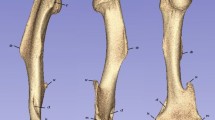Abstract
Background
The composition of navicular joint complex is crucial to perform surgical interventions for multiple pathological foot aetiologies. The data on human navicular bone and its facets from Indian population remain scarce in literature.
Aims and objectives
To evaluate the morphometry and morphology of navicular bone.
Methodology
A total of 77 (right: 40; left: 37) dried human navicular bones were used. The collected data were entered and analysed in SPSS software.
Results
The anteroposterior diameter of navicular bone on right side was 15.19 mm (13.92, 16.77) and on left side was 15.87 mm (13.83, 17.27). The transverse diameter on right and left sides were 34.21 mm (31.74, 36.6) and 33.59 mm (30.23, 35.43), respectively. The vertical diameter measured on the right was 22.31 mm (21.19, 23.94) and on left 22.53 mm (20.8, 24.24). Morphometric evaluation showed no significant difference between right and left navicular bones. The commonest shape for posterior facet was quadrilateral, on the right (62.5%) and left (40.5%). The most common shape of anterior facet for medial cuneiform is quadrilateral, on the right (85%) and left (89.1%). For intermediate cuneiform, triangular facet was common on the right side (72.5%) and on the left (59.5%). The lateral cuneiform facet was bean shaped on right side (72.5%) and quadrilateral on the left side (32.5%). There was a significant difference in shape distribution between right and left (P < 0.05). The median length of the groove for tibialis posterior tendon was 18.01 mm and 16.19 mm on right and left side, respectively. Cuboid facet was observed in 28 (70%) and 26 (65.9%) navicular bones on right and left sides, respectively.
Conclusion
There is no significant difference between right and left bones with regards to morphometric parameters. Morphological evaluation revealed significant difference in the distribution of shape between right and left bones.




Similar content being viewed by others
Data availability
All data underlying the results are available as part of the article and no additional source data are required.
References
Chan JY, Young JL (2019) Köhler disease. Avascular necrosis in the child. Foot Ankle Clin 24(1):83–88
DiGiovanni CW (2004) Fractures of the navicular. Foot Ankle Clin 9(1):25–63
Gheewala R, Arain A, Rosenbaum AJ. (2023) Tarsal Navicular Fractures. In: Stat Pearls [Internet]. Treasure Island (FL): Stat Pearls Publishing; 2023 Jan-. Available from: https://www.ncbi.nlm.nih.gov/books/NBK542221/
Golano P, Fariñas O, Sáenz I (2004) The anatomy of the navicular and periarticular structures. Foot Ankle Clin 9(1):1–23
Kaye RA, Jahss MH (1991) Tibialis posterior: a review of anatomy and biomechanics in relation to support of the medial longitudinal arch. Foot Ankle 11(4):244–247
Kitaura Y, Nishimura A, Nakazora S, Fukuda A, Senga Y, Kato K, Sudo A (2019) Spontaneous osteonecrosis of the tarsal navicular: a report of two cases. Case Rep Orthop 30:5952435
Manners-Smith T (1907) A study of the navicular in the human and anthropoid foot. J Anat Physiol 41(Pt 4):255–279
Marshall D, MacFarlane RJ, Molloy A, Mason L (2020) A review of the management and outcomes of tarsal navicular fracture. Foot Ankle Surg 26(5):480–486
Peeters K, Schreuer J, Burg F, Behets C, Van Bouwel S, Dereymaeker G et al (2013) Alterated talar and navicular bone morphology is associated with pes planus deformity: a CT-scan study. J Orthop Res 31(2):282–287
Perisano C, Greco T, Vitiello R, Maccauro G, Liuzza F, Tamburelli FC, Forconi F (2018) Mueller-Weiss disease: review of the literature. J Biol Regul Homeost Agents 32(6 Suppl. 1):157–162
Renner K, McAlister JE, Galli MM, Hyer CF (2017) Anatomic description of the naviculocuneiform articulation. J Foot Ankle Surg 56(1):19–21
Saldías E, Malgosa A, Jordana X, Isidro A (2019) Morphological and biomechanical implications of cuboid facet of the navicular bone in the gait. Int J Morphol 37(4):1397–1403
Samim M, Moukaddam HA, Smitaman E (2016) Imaging of Mueller-Weiss syndrome: a review of clinical presentations and imaging spectrum. AJR Am J Roentgenol 207(2):W8–W18
Smith CF (1999) Anatomy, function, and pathophysiology of the posterior tibial tendon. Clin Podiatr Med Surg 16(3):399–406
Trammell AP, Davis DD, Scott AT. Kohler Disease. (2023). In: StatPearls [Internet]. Treasure Island (FL): StatPearls Publishing; 2023 Jan–. PMID: 29939608
Tuthill HL, Finkelstein ER, Sanchez AM, Clifford PD, Subhawong TK, Jose J (2014) Imaging of tarsal navicular disorders: a pictorial review. Foot Ankle Spec 7(3):211–225
Funding
None.
Author information
Authors and Affiliations
Contributions
NR and SS collected the data, reviewed the literature and drafted the manuscript. NR performed the data analysis. SV critically revised the manuscript. All authors contributed to review of literature, drafting of the manuscript and approved the final version of the manuscript. SV shall act as guarantor of the paper.
Corresponding author
Ethics declarations
Conflict of interests
None stated.
Ethics approval
Waiver of consent approval was obtained from Institute ethics committee and the study was performed in accordance to ethical standards laid by declaration of Helsinki 1964.
Additional information
Publisher's Note
Springer Nature remains neutral with regard to jurisdictional claims in published maps and institutional affiliations.
Rights and permissions
Springer Nature or its licensor (e.g. a society or other partner) holds exclusive rights to this article under a publishing agreement with the author(s) or other rightsholder(s); author self-archiving of the accepted manuscript version of this article is solely governed by the terms of such publishing agreement and applicable law.
About this article
Cite this article
Rajaram, N., Srinivasan, S. & Verma, S. Human navicular bone: a morphometric and morphological evaluation. Surg Radiol Anat 46, 71–79 (2024). https://doi.org/10.1007/s00276-023-03259-9
Received:
Accepted:
Published:
Issue Date:
DOI: https://doi.org/10.1007/s00276-023-03259-9




